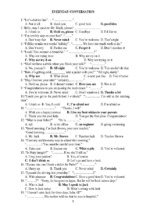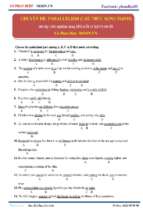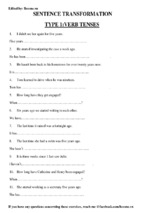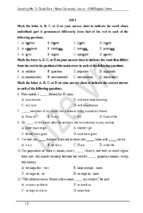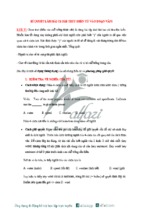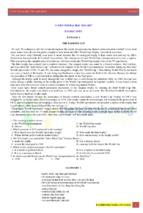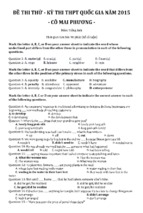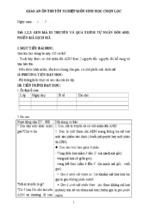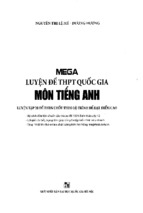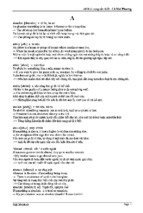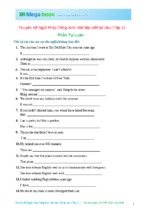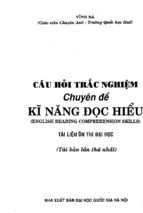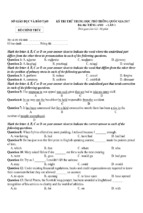SECTION 3: GRAMMATICAL RELATIONS
18 Structure
“The concept of STRUCTURE is essential in distinguishing between the
strings of words that are well-formed expressions in the language
and those that are not.” [Burton-Roberts, 1997: 8] To show how things can
be analyzed into their constituent parts in this text, we use TREE-DIAGRAMS —
the trees that are upside-down:
S
NP
VP
DET
N’
DEM
headN
These
AP[sP/sC]
Vgrp
[intens]
A
concepts
are
basic.
This does not prevent us from having a quick look at some other
common types of diagrams:
� Fries’ diagrams (also called UPSIDEDOWN-T DIAGRAMS) in
Stageberg [1965] and Barsova et al [1969]:
These concepts are basic
� Candelabra’s diagrams in Barsova et al [1969]:
these concepts are basic
� Reed and Kellogg’s diagrams in House and Harman [1965]:
concepts are
these
basic
_________________
19 Endocentric structures vs. exocentric structures
19.1 ENDOCENTRIC STRUCTURE
Phrases like the NOUN PHRASE (NP, for short) their rather dubious
jokes are said to be ENDOCENTRIC. “An endocentric construction may be
99
substituted for as a whole by one of its constituent units; e.g. a noun may
stand for the whole noun phrase, c.f. big African lions roaming in the
jungle — lions.” [Jackson, 1980: 26]
19.2 EXOCENTRIC STRUCTURE
Phrases like the PREPOSITIONAL PHRASE (PP, for short) beside a
⇔,
stream are said to be EXOCENTRIC. There is a TWO-WAY DEPENDENCE (⇔
for short) between beside and a stream as a whole: both of the two
constituents must occur to form the PP beside a stream; “one of them
cannot stand for the whole phrase” [Jackson, 1980: 26].
However, the PP beside a stream can also be considered
ENDOCENTRIC: “Although beside and a stream are both needed to express
the spatial orientation in this case, it is the word beside that is giving the
phrase as a whole its locational character. So beside is the head of the
phrase.” [Burton-Roberts, 1997: 43] If the PREPOSITION (P, for short)
beside is the HEAD (H, for short) of the prepositional phrase beside a
stream then a stream is functioning as COMPLEMENT (C, for short) to that
head: (H) beside ⇔ a stream (C).
“Each phrase must have a head. A noun phrase has a noun as head, a
verb phrase has a verb as head, a prepositional phrase a preposition as
head, and an adjective phrase an adjective as head.” [Jacobs, 1995: 51]
Briefly, the STRUCTURES of MODIFICATION, COMPLEMENTATION, and
CO-ORDINATION are all endocentric whereas THE STRUCTURE OF
PREDICATION is exocentric. As to a prepositional phrase, it may be regarded
either as an exocentric structure or as an endocentric structure.
_________________
20 Types of syntactic structures
20.1 STRUCTURE OF MODIFICATION
There is a one-way dependence (⇒
⇒, for short) in the STRUCTURE of
MODIFICATION. In the phrase their rather dubious jokes, rather is
dependent on dubious, in the sense that it is only present because dubious
is. If we are to omit dubious, rather will be left without a function, and the
100
omission would result in an ill-formed string (*their rather jokes). Notice,
however, that dubious is in no way dependent on rather. We can omit
rather and still be left with a perfectly good phrase (their dubious jokes).
And rather dubious as a whole is dependent on jokes but not viceversa. Rather dubious (the modifier of the phrase) could be omitted
(giving their jokes), but jokes (the head of the phrase) could not (*their
rather dubious).
(modifier) rather ⇒ dubious (head)
(modifier) rather dubious ⇒ jokes (head)
(modifier) their ⇒ rather dubious jokes (head)
Thus, ‘their rather dubious jokes’ is a typical example of the
STRUCTURE OF MODIFICATION.
20.2 STRUCTURE OF COMPLEMENTATION
There is a two-way dependence (⇔
⇔, for short) in the STRUCTURE of
COMPLEMENTATION. Both the monotransitive verb saw and the noun phrase
many things must occur to form the verb phrase saw many things: saw is
its head and many things is the complement of that head:
(head) saw ⇔ many things (complement)
Since one of the two constituents cannot stand for the whole verb
phrase as a unit, ‘saw many things’ is a typical example of the STRUCTURE
of COMPLEMENTATION.
20.3 STRUCTURE OF COORDINATION
“Max and Adrian is a COORDINATE NOUN PHRASE (Co-NP, for short),
with Max and Adrian coordinated by and. Co-ordinate NPs have as many
heads as there are nouns coordinated in them. Other COORDINATORS are
but and or.” [Burton-Roberts, 1997: 67]
In Stageberg’s opinion [1965: 273], the coordinator “is set off as a
separate element and does not belong to either IC”:
101
Co-NP
NP1
Co-NP
Conj
N1
(1)a. Max
and
NP2
NP1
NP2
N2
N1
N2
Conj
NP3
N3
(1)b. sandwiches, relish, and coffee
Adrian
Stuffy and hot is a COORDINATE ADJECTIVE PHRASE (Co-AP, for
short), with stuffy and hot coordinated by and. This Co-AP can be premodified by too, which is a DEGREE ADVERB (DEG, for short) as in (2)a.
Stuffy and too hot is another Co-AP, with stuffy and too hot
coordinated by and. In this case, too only pre-modifies the ADJECTIVE (A,
for short) hot as in (2)c. Describe the internal structure of the phrase marked
(2)b. In what way(s) is it different from that of (2)a?
AP
Co-AP
DEG
Co-AP
A1
Conj
AP1
A2
DEG
Co-AP
Conj AP2
A
AP1
A
A
Conj
AP2
DEG
A
(2)a. too stuffy and hot (2)b.too stuffy and hot (2)c. stuffy and too hot
The prepositional phrase up and down the stairs contain a COORDINATION OF PREPOSITIONS (Co-P, for short), with up and down
coordinated by and as in (3)a. In the foundation and under the rafters
is a COORDINATE PREPOSITIONAL PHRASE (Co-PP, for short), with in the
foundation and under the rafters coordinated by and as in (3)b.
PP
NP
Co-P
P1 Conj
Co-PP
P2
PP1
the stairs
(3)a. up and down
P1
PP2
Conj
NP1
P2
NP2
(3)b. in the foundation and under the rafters
Two important points to notice about the co-ordinations marked (1)a-b,
(2)a-c and (3)a-b are � that “the mother and the sisters of the
102
coordinator (and in this case) all have the same category label”
[Burton-Roberts, 1997: 71] and � that “the parts joined by Coordinate
Conjunctions ought usually to be of exactly equal value” [Campbell,
1962: 5]. All these co-ordinations are typical examples of the STRUCTURE of
COORDINATION.
20.4 STRUCTURE OF PREDICATION
Wherever possible, a SENTENCE (S, for short) should be divided into
the fewest possible parts, i.e. into two: a NOUN PHRASE (NP, for short) and a
VERB PHRASE (VP, for short).
S
NP
(subject)
VP
(4)a. Ducks
b. The ducks
c. Those gigantic ducks
d. The mouth-watering duck on the table
e. The ones over there
f. Those on the left
g. Mine
h. These
i. They
(predicate)
paddled.
are paddling away.
were paddling away furiously.
won’t be paddling away again.
must have paddled for a while.
have been paddling noisily.
kept on paddling quickly.
did paddle.
did.
The sentences (4)a-i have all been divided into two constituents; the
first is traditionally said to function as SUBJECT, and the second as PREDICATE.
“One way of thinking of these functions is to think of the subject as being
used to mention something and the predicate as used to say something
true or false about the subject.” [Burton-Roberts, 1997: 31]
While the noun phrase and the verb phrase of the sentences
marked (4)a-i display the STRUCTURE of MODIFICATION, the very
sentences are typical examples of the STRUCTURE of PREDICATION.
_________________
103
21 Constructions vs. constituents
21.1 A construction is any significant group of words (or morphemes):
old man, lives there, the man who lives there, has gone, to his son’s
house, has gone to his son’s house, the old man who lives there has
gone to his son’s house, etc.
But there has is not, since the two words have no direct connection.
Neither is man since this word contains only one word (and also one
morpheme). On a syntactic level lives is not a construction; but on a
morphological level it is a construction consisting of two morphemes, live
and −s.
21.2 A constituent is any word or construction (or morpheme) which
enters into some larger construction. Thus, each of the words in the
sentence ‘The old man who lives there has gone to his son’s house.’ is
a constituent. So are the two constructions old man and the old man who
lives there.
However, there has or man who is not a constituent. Neither is the
sentence as a whole since there is no larger construction of which it is a
part.
Briefly, all but the smallest constituents are constructions and all
but the largest constructions are constituents. In syntax, the smallest
constituents are words, and the largest constructions are sentences.
_________________
22 Immediate constituents vs. ultimate constituents
22.1 An IMMEDIATE CONSTITUENT (an IC, for short) is one of the two
constituents of which any given construction is directly formed. In
other words, “each of the two parts into which any structure is
divided” [Stageberg, 1965: 263] is called an IMMEDIATE CONSTITUENT.
The IC’s of a given construction are its constituents on the next
lower level:
104
the old man who lives there | has gone to his son’s house
the old man | who lives there
who | lives there
the | old man
lives | there
old | man
has gone | to his son’s house
has | gone to | his son’s house
his son’s | house
his son | ’s
his | son
are the smallest constituents of
22.2 ULTIMATE CONSTITUENTS
which a given construction is composed.
If the ultimate constituents of a word are “the unit morphemes
of which it is composed” [Stageberg, 1965: 98] then the ultimate
constituents of a sentence are the individual words (or the possessive
morpheme in some cases) of which it is composed.
There are thirteen ultimate constituents in the old man who lives
there has gone to his son’s house: the, old, man, who, lives, there,
has, gone, to, his, son,’s and house.
_________________
23 Immediate constituents of a sentence
Using the diagram marked (1) as an illustration, one may say “yes” to
the question “Are words the immediate constituents of the sentence that
contains them?”
S
(1) Old Sam sunbathed beside
a
stream.
Compare the diagram marked (1) with the diagrams marked (2) and (3):
S
*(2) Stream old Sam sunbathed beside a.
S
*(3) Sunbathed old beside stream a
Sam.
The diagram marked (1) fails to give any explanation of why the
words that occur in (1) form a well-formed English sentence, and why
those that occur in (2) and (3) do not.
105
“The arrangement of words in a sentence is largely determined by the
fact that the words are not immediate constituents of the sentences, but
belong with other words to form groups which have their own specifiable
position in the structure of the sentence. In short, while sentences CONTAIN
words, they don’t CONSIST (just of) words.” [Burton-Roberts, 1997: 11-12]
_________________
24 Intervening level of organization between word and sentence
The fact that words do not pattern directly into sentences
implies that there are some intervening levels of organization between
word and sentence. They are usually called phrase, and clause [Jackson,
1980: 4].
The sentence marked (1) consists of two phrases: a noun phrase as the
subject and a verb phrase as the predicate.
(1) My bother was an outstanding student.
The sentence marked (2) consists of two independent clauses that
are coordinately linked by the conjunction ‘but’:
(2) My bother was an outstanding student, but I was not.
_________________
25 Modifiers vs. complements
25.1“A modifier is a subordinate element in an endocentric
structure. It is a word or a word group that affects the meaning of a
headword in that it describes, limits, intensifies and/or adds to the
meaning of the head. In the noun cluster the blue shirt, for example, the
word blue describes the shirt; it limits by excluding other colours; and it
adds to the plain meaning of shirt.
Modifiers may appear before or after the heads they modify, and
sometimes they are separated from the head by intervening words”
[Stageberg, 1965: 230-231]:
a butterfly in the garden which was fluttering among the flowers
25.2 The term complement may be used to refer to various linguistic notions.
Richards, Platt and Weber [1985] and Jacobs [1995] share something in
common in reference to the term complement when the former [1985: 52]
106
states that a complement is “that part of the sentence which follows the verb
and which thus completes the sentence” and the latter [1995: 59] believes
that “a complement is the phrase following the predicate and linked very
closely to it; it is the constituent that ‘completes’ the predicate. However,
these authors differ in what they consider as complements.
The complements according to Richards, Platt and Weber [1985:52] are:
� subject complement: the complement linked to a subject by be or
an intensive verb: She IS a doctor.
� object complement, i.e. the complement linked to an object:
We MADE her the chairperson.
� adjective complement, i.e. the complement linked to an adjective:
I’M glad that you can come.
� complement of a preposition, i.e. the complement linked to a preposition:
They ARGUED about what to do.”
In addition to subject and object complements [1995: 58-60] and
adjective and prepositional complements [1995: 99], Jacobs also presents
noun complements [1995: 99-101]: “Many nouns … takes complement
clauses or complement prepositional phrases:
that Eleanor had met with the senator
the news of her marriage.”
the story
Unlike Jacobs [1995] and Richards, Platt and Weber [1985],
Stageberg’s [1965: 165] complements also cover direct and indirect
objects: “The complements is the generic term for the completers of the
verb, which we shall later learn to know as direct object, indirect object,
object complement, and subject complement (with its subclasses of
predicative noun, predicative pronoun, and predicative adjective.”
Later in his textbook, Stageberg [1965: 275] presents “the
complement of the adjectival” but says nothing concerning either noun
complements or complements of a preposition.
_________________
107
26 Types of adjective complements
An adjectival complement completes the meaning of the adjective
head in a predicative adjective phrase. There are various kinds of
complements in a predicative adjective phrase:
� A prepositional phrase: averse, free and tantamount must take as its
complement a prepositional phrase:
(1)a. I’M NOT averse to a cup of tea.
b. ARE you free from all responsibilities?
c. Her remarks WERE tantamount to slander.
� A non-finite to-infinitive clause: Loath must take as its complement a
non-finite to-infinitive clause:
(2) They WERE loath [E
E]TO LEAVE this district.
� A finite dependent clause: Aware must take as its complement a finite
dependent clause1:
(3)a. He IS aware that very few jobs ARE available.
b. I don’t think you ’RE aware how much this MEANS to me.
_________________
27 Pre-adjectival modifiers vs. post-adjectival modifiers
An attributive adjective can only take an optional pre-modifier
while a predicative adjective may optionally be pre-modified and
optionally or obligatorily post-modified.
27.1 The pre-modifier in an adjective phrase, either attributive or
predicative, may only be an adverb:
(1)a. It IS a very exciting film.
b. This film IS very exciting.
27.2 Predicative adjectives, not attributive adjectives, may take
post-modifiers:
(2)a. *She IS a somewhat anxious about his son’s health mother.
b. She IS somewhat anxious about his son’s health.
1
Aware can also take as its complement a prepositional phrase:
He WAS aware of a creaking noise.
108
27.3 There are various kinds of post-modifiers in a predicative
adjective phrase:
� A prepositional phrase:
(3)a. My roommate BECAME tired of studying.
b. The dean WAS NOT angry with me.
c. I’M worried about your study.
� A non-finite to-infinitive clause:
E] TO SEE her.
(4)a. Jack APPEARED eager [E
b. We WERE reluctant [E
E] TO LEAVE.
c. Jane WAS delighte
delighted
d [E
E] TO RECEIVE the gift.
� A finite dependent clause:
(5)a. I’M glad that it IS over.
b. She IS indifferent whether you COME or not.
_________________
28 Adjective complements vs. optional post-adjectival modifiers
28.1 For most predicative adjectives, post-modification is optional.
In other words, an adjective phrase functioning predicatively does not always
obligatorily contain a certain kind of post-modifier. Anxious and devoted,
for example, can occur with or without post-modification:
(1)a. Mrs Green IS devoted.
b. Mrs Green IS really devoted.
c. Mrs Green IS really devoted to her daughter.
(2)a. He IS anxious.
b. He IS (very) anxious.
c. He IS (very) anxious about his wife’s health.
d. He IS (very) anxious [E
E] TO PLEASE everybody.
e. He IS (very) anxious that no one SHOULD ACCUSE him of laziness.
28.2 For other predicative adjectives, however, post-modification is
obligatory.
� Averse, free and tantamount are always followed by a prepositional
phrase:
109
(3)a. I’M NOT averse to a cup of tea.
b. ARE you free from all responsibilities?
c. Her remarks WERE tantamount to slander.
� Loath is always followed by a non-finite to-infinitive clause:
(4) They WERE loath [E
E] TO LEAVE this district.
� Aware must take as its complement either a prepositional phrase or
a finite dependent clause:
(5)a. He WAS aware of a creaking noise.
b. He IS aware that very few jobs ARE available.
c. I don’t think you’RE aware how much this MEANS to me.
� Afraid must take as its complement either a prepositional phrase or a
finite dependent clause beginning with the subordinator “that”:
(6)a. She WAS afraid of what MIGHT HAPPEN
if Edward turned round and saw her.
b. She WAS afraid of losing customers.
c. She WAS afraid that
that he MIGHT LOSE customers.
The obligatory post-adjectival modifier should be called THE
COMPLEMENT of the head adjective in a predicative adjective phrase to be
distinguished from any possible optional post-adjectival modifier of the
head adjective.
An adjective may be both pre-modified and post-modified. Preadjectival modifiers are always optional whereas post-adjectival
modifiers may be either optional or obligatory. The combination of an
adjective and its optional post-modifier is an example of THE STRUCTURE
OF MODIFICATION whereas the combination of an adjective and its
obligatory complement displays THE STRUCTURE OF COMPLEMENTATION.
Thus, it is crucial to observe what follows the head adjective in a
predicative adjective phrase and to determine whether it is A
COMPLEMENT
110
or A MODIFIER.
29 Classification of English adjectives according to their post-modifiers
We may give a affirmative answer to the above question because
English adjectives vary in the kinds of post-modifiers that are possible
after them:
29.1 Many adjectives do not allow any post-modifier (though they may
take a pre-modifier): big, blue, astute, sudden, tall, criminal, etc.:
(1)a. This IS another really big problem.
b. This problem IS really big.
(2)a. She HAS blue eyes.
b. Her eyes ARE blue.
(3)a. It’S a criminal waste of public money.
b. Their actions ARE criminal.
29.2 Some adjectives allow one or more kinds of optional post-modifiers:
�Interesting may take only an infinitive (phrase):
(4) His book IS interestin
interesting
g to read.
�Attentive allows only a prepositional phrase:
(5) The audience WAS attentive tothe speaker.
�Safe allows either a prepositional phrase or an infinitive phrase:
(6)a. This toy IS safe for children.
b. This tree IS safe to climb up.
� Anxi
Anxious
ous, however, take all three kinds of post-modifiers:
(7)a. He IS very anxious about his wife’s health,
b. He IS very anxious to please everybody,
c. He IS very anxious that no one should accuse him of laziness.
29.3 Some adjectives require one or more kinds of oblibatory postmodifiers, which are also known as adjectives complements:
� Fond and tantamount must take as its complement a prepositional
phrase:
111
(8)a. I’M fond of swimming.
b. Her remarks WERE tantamount to slander.
� Loath must take as its complement a non-finite to-infinitive clause:
(9) They WERE loath [E
E] TO LEAVE this district.
� Aware must take as its complement either a prepositional phrase or a
finite dependent clause:
(10)a. He WAS aware of a creaking noise.
b. He IS aware that very few jobs ARE available.
c. [I don’t think] you’RE aware how much this MEANS to me.
� Afraid must take as its complement either a prepositional phrase or a
finite dependent clause beginning with the subordinator “that”:
(11)a. She WAS afraid of losing customers.
b. She WAS afraid that he MIGHT LOSE customers.
c. She WAS afraid of what MIGHT HAPPEN
if Edward turned round and saw her.
_________________
30 Types of adverbial adjuncts
30.1 All VPs are optionally modified by one or more adverbial adjuncts
which “provide circumstantial information about the action, process or event
talked about in the clause in which they occur. Circumstantial information
includes information about the place, time, manner, etc. of the action, process
or event” [Jackson, 1980: 25]. Being adverbials, adjuncts are frequently in
form of adverbs or adverb phrases, prepositional phrases, infinitive phrases,
participial phrases and subordinate finite clauses.
30.2 Adverbial adjuncts can be sub-categorised according to the meanings
they express. Note that �the adverbial adjunct in question is underlined
and the Vgrp IS CAPITALISED for better identification and that �only
INTRANSITIVE VERBS are employed to simplify the following analysis a bit:
112
30.2.1 Adverbial adjuncts of Time have four subcategories within them:
� Adverbial adjuncts of Point of Time tell when an event takes place,
answering the question ‘When?’ or ‘At what time?’:
(1)a. My father WORKS at night.
b. We’LL BE FLYING over France at eight thirty tonight.
c. I’LL COME some time/next week.
d. They ARRIVED the next day/at a quarter past nine.
� Adverbial adjuncts of Duration or Extent in Time describe how
long an event lasts, answering the question ‘How long?’:
(2)a. I’D LIKE TO GO for a week in silence.
b. The two drivers MUST STAY until the police get there.
c. He WORKS hard from morning till night.
d. The bell RANG all day long.
e. It LASTED years.
f. I’VE BEEN WORKING here since 1981/since I graduated from my
university.
� Adverbial adjuncts of Frequency describe how often an event
occurs, answering the question ‘How often?’ or ‘How many times?’:
(3)a. He COMES home late from time to time.
b. We MEET twice a week and EAT OUT every Friday evening.
c. The roof LEAKS whenever it rains.
d. The electrician always/usually/often/sometimes/rarely/never
WORKS overtime.
� Adverbial adjuncts of Temporal relationship convey the temporal
relationship between two events or states, answering the question ‘When?
(4)a. After this the conversation SANK for a while into mere sociability.
b. They HAD ARRIVED before the meeting started.
30.2.2 Adverbial adjuncts of Place (also called Space) have six
subcategories within them:
� Adverbial adjuncts of Location or Position describe the very place
in, on or at which an action occurs, answering the question ‘Where?’:
(5)a. They STOMPED upstairs.
113
b. My sister and her boyfriend MET at a dance.
c. I CAN hardly STUDY at home.
d. A Panamanian passenger bus LAY in a ditch.
e. He always HIDES where I can never reach.
� Adverbial adjuncts of Distance or Extent in Space include both
general description of distance and specific measurements of an action,
answering the question ‘How far?’:
(6)a. I CAN’T WALK much farther.
b. We RAN no more than two blocks.
c. I’LL JOG as far as I can.
d. You SHOULD NOT GO too near/too close.
e. They’VE WALKED for seven miles.
� Adverbial adjuncts of Direction give a general orientation or the
direction of an action, answering the question ‘In what direction?’:
(7)a. A visitor CAME in.
b. A tiger HAS GOT out.
c. We ARE FLYING due north.
d. Opinion IS SHIFTING in favour of the new scheme.
� Adverbial adjuncts of Terminus describe the direction of an action
towards a destination, answering the question ‘Where?’:
(8)a. The director HAS COME home.
b. She GOES to the church to take a few pictures.
c. He JUMPED onto the ground/into the air.
d. They GO where(ever) they are told.
� Adverbial adjuncts of Source describe the direction of an action
from a point of origin, answering the question ‘From which?’ ‘From where?’
or ‘From whom?’:
(9)a. She GRADUATED from Cambridge with a degree in law.
b. He BORROWED freely from other writers.
c. He JUMPED off the roof.
d. He’S COME straight back from the construction site.
114
� Adverbial adjuncts of Path describe the pathway of an action,
answering the question ‘By/Through/Along/Via/By way of which?’:
(10)a. They ARE TRAVELING to France by way of London.
b. You CAN GO from London to Washington via New York.
c. He JUMPED out of the window/over the wall.
d. A lot of vehicles TRAVEL along the street.
e. The train WHISTLED past (the village).
f. We CAME by country roads, not by the motor road.
g. The burglar GOT in through the window and ESCAPED through the
back door.
30.2.3 Adverbial adjuncts of Manner describe the way in which
something is done, answering the question ‘How?’ or ‘By what way?’:
(11)a. The gears WORK very smoothly.
b. She CAME in gently/in a gentle way.
c. He JUMPED this way.
d. I LINGERED on purpose.
e. He BEHAVES quite strangely/in a very strange way/as if he is
going to be attacked.
30.2.4 Adverbial adjuncts of Behalf or Guise answer the question
‘Who for?’, ‘Instead of whom?’, ‘On behalf of whom?’, ‘What as?’ or ‘What
into?’:
(12)a. I COME here as a friend.
b. Tom CAME instead of Paul.
c. He SET out poor/as a pauper.
d. He CAME back rich/a rich man/as a millionaire.
e. Mavis LEFT the house a smiling, confident woman.
30.2.5 Adverbial adjuncts of Comparison compare the manner of a
state or action relative to another, answering the question ‘How?’
(13)a. Our coach LEFT earlier than it should have done.
b. This M.C. SPEAKS more fluently than accurately.
c. He DID as much as he could.
115
d. The students CAN’T TRANSLATE as well as their professor does.
e. You MUST TRANSLATE as accurately as possible.
f. The lip CURLED like a snail’s foot.
30.2.6 Adverbial adjuncts of Accompaniment lie along the
continuum from clearly conveying manner to encompassing more ambiguous
meanings. They usually answer the question ‘With/Without whom?’,
‘With/Without what?’ or ‘And who/what else?’:
(14)a. I WENT to the ball with the handsome Prince Igor.
b. I LEFT with someone else.
c. He’S COMING downstairs with two sleeping bags over the top of
his head.
The adverbial adjuncts in (14)a-b show physical accompaniment.
Though they are not always obviously answers to a ‘How?’ question, they can
be replaced by the opposite adverbial adjuncts of Manner such as
independently or by myself and thus fit the manner category most clearly. In
some sense, the adverbial adjunct in (14)c conveys information about the
Manner of ‘coming downstairs’, but the precise semantic relationship between
this adverbial adjunct and the rest of the clause is difficult to define. Below
some more adverbial adjuncts of Accompaniment:
(14)d. I CAN’T LIVE without you.
e. I’VE COME out without any money.
f. Tom CAME as well as Paul.
30.2.7 Adverbial adjuncts of Means tell the means by which an
activity or state was accomplished, answering the question ‘How?’ or ‘By what
means?’:
(15)a. Mrs. Brown never TRAVELS by air.
b. They GOT over to that deserted village on foot/on horseback.
c. I GO to work by bus.
d. He GOT here by running all the way from home.
30.2.8 Adverbial adjuncts of Instrument describe the item used to
undertake a task, answering the question ‘With/Without what?’:
116
(16)a. The prisoner ESCAPED with only a razor blade.
b. I CAN hardly STUDY without an up-to-date dictionary.
c. She frequently WRITES in pencil.
d. You SHOULD NOT READ by artificial light.
e. They usually PAY in cash, not by check.
f. She often SEWS with cotton thread.
30.2.9 Adverbial adjuncts of Cause and of Reason both answer the
question ‘Why?’ Traditionally, cause has been associate with a relatively
objective statement, as in (17)a-c, while reason has implied a more
subjective assessment, as in (17)d-e:
(17)a. He [was buried under bricks, and] DIED of head injures.
b. We MISSED the plane through being held up on the motorway.
c. The old man WALKED slowly because of his bad legs/
because his legs are bad.
d. I WENT there because I was told.
e. I’VE BEEN WAITING here as I know you’ll certainly come and pick
me up.
In the majority of cases, however, it is difficult to judge the level of
objectivity and thus to discern between cause and reason, as with the
following examples:
(17)f. The plan FELL down because it proved to be expensive.
g. He THRIVES on positive criticism.
30.2.10 Adverbial adjuncts of Contingency, like adverbial adjuncts
of Cause, also answer the question ‘Why’. However, it is necessary to note
that adverbial adjuncts of Cause “give as a reason of something which is
happening, has happened, or will happen” while adverbial adjuncts of
Contingency “give as a reason of something which might have happened, or
which may happen” [Campbell, 1962: 59]. The first is certain, the second is
only possible or probable, as shown in (18)a-d:
(18)a. They DECIDED to retreat at once
for fear (that)/lest they should be cut from the main force.
b. You SHOULD LEAVE immediately in case of fire.
117
c. You HAD BETTER NOT SKI in case the weather is really bad.
d. We STARTED early for fear of a possible traffic jam.
30.2.11 Adverbial adjuncts of Purpose answer the question ‘What
for?’ or ‘For what purpose?’:
(19)a. I’VE GOT TO WRITE to report what I’ve been doing so far.
b. She just WORKS for her own account.
c. He’S GONE on business, not for pleasure.
d. I JOG for the sake of my health.
e. The ground crew even CRAWLED into the un-pressurised luggage
compartments so as not to be left behind.
f. They always WALK
so that/in order that they may/might get plenty of exercise.
Purpose is also closely related to reason, it is possible, for example, to
paraphrase (19)a as ‘The reason I’ve got to write IS to report what I’ve been
doing so far.’
30.2.12 Adverbial adjuncts of Result:
“In Purpose Sentences something is done deliberately in order to bring
about a certain result. The Subordinate Clause often has MAY or MIGHT. In
Result Sentences something happens by chance and brings about a certain
result. The Subordinate Clause never has MAY or MIGHT.” [Campbell,1962: 58]
(20)a. He DRANK so much that he’s got stomachache.
b. My father SMOKED so heavily that he got lung cancer.
c. He JUMPED so high that he easily crossed the barrier.
d. The third couple DANCED so beautifully that all the examiners
awarded them the maximal point.
30.2.13 Adverbial adjuncts of Concession express material that
runs counter to the proposition of the rest of the clause or, in the case of
adverbial adjuncts realized as clauses, counter to the proposition in the
main clause:
(21)a. He DOESN’T SUCCEED however hard he tries.
b. She FAILS however much she does.
118
- Xem thêm -

